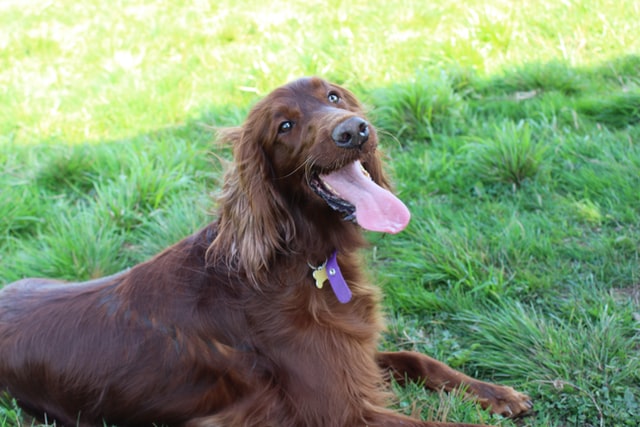The Irish Setter is one of the world’s gorgeous breeds. Their beautiful flowing red cloak is a perfect reflection of their devotion to the Emerald Isle. These canines, however, have more to offer than simply their beauty queen reputation. The Irish are skilled athletes with a soft and easygoing disposition who blends in well with family life.
The Irish Setter is a muscular and elegant breed. Their silky hair cascades gently over muscular muscle. This breed is not recognized for its ability to guard. They are vigilant but not particularly noisy. Owners are concerned about their dogs’ behavioral issues.
Surprising Irish Setter Behavior and Maintenance Issues

❕ They do not Function Properly when Left Alone
Irish setters are a breed that struggles when left alone for extended periods of time. They build close relationships with their families rapidly and desire human interaction. This might be problematic for families that work long hours or leave the house unoccupied during the day.
The negative consequences of a dog spending too much time alone are vast. Stress, destructive conduct, and separation anxiety are all symptoms of stress.
Once established, they are challenges that are extremely difficult to overcome. Consider your daily routine and job schedule. And whether or not your household is frequently empty. If this is the issue, this breed may not be for you.
❕ They are Stubborn
Stubbornness is inherited in pets as well. It is true that this differs greatly. Some Setters are more obstinate than others, and there are no certainties as to whether or not your setter will be.
However, it is a character that setter owners constantly discuss. Stubbornness may sometimes lead to funny stand-offs. At times, it causes a great deal of frustration.
Another reason why practicing and knowing fundamental commands to a high degree is critical. If you actively begin teaching your setter as soon as you get them home, you will encounter far less disobedience.
❕ They go through Naughty Adolescent Phases
This is not true of all Irish setters. However, during their adolescent years, the possibilities of abusive behavior and disobedience are much greater.
Fortunately, with appropriate exercise levels, training, and frequent engagement, this can usually be avoided. To be reasonable, this is the same for any working breed and even some non-working breeds.
Adolescent dogs maybe impetuous, energetic, and highly demanding. That’s all quite typical at this period of their lives. However, it is required to be aware of this ahead of time.
❕ They Shed a Lot
Prepare for fresh red carpets. Setters from Ireland shed. Even if they are relatively modest shedders, it will come as a surprise to a family that is currently pet hair-free. They need an active grooming commitment, particularly brushing.
An Irish setter’s double coat sheds almost all year, with two distinct phases in the spring and right before winter. Shedding is something you’ll have to cope with for most of your life. But then it is something that can be dealt with.
Brushing should be done in little, frequent bursts. To keep their coat in outstanding condition, a simple 15-20 minute brushing routine every other day will be required.
The Best Way to Care for an Irish Setter

Irish Setters are happy, bright, and energetic dogs. They make excellent family dogs. They are also often kind to children and other pets. Making sure your Irish Setter gets plenty of exercises is part of caring for it.
Also, switch up the things you do together. And because the breed is prone to a few health difficulties, it’s critical to understand their typical behavior.
✔️ Allow them to Get Lots of Exercises
Make sure your dog receives at least one to two hours of daily activity. Irish Setters are energetic dogs and need at least one walk. Allow them 30 to 60 minutes of walking every day.
Considering Irish Setters were developed as hunting dogs, they require regular fetch and other vigorous sports in addition to walks. Make an effort to preserve an active lifestyle. If you want a more calm lap dog, seek a different breed.
Irish Setters do well if their owners have nice-sized grounds and adequate room. Irish Setters require a lot of time with their parents because they are such a high-energy breed. They may be prone to disruptive behavior or separation anxiety if they spend many hours or longer alone.
✔️ Give them Activities
They should vary their activities. Switch up the way you take your Irish Setter on walks to introduce your dog to new sights and smells. As often as possible, take it hiking, swimming, dog parks, and other unique activities.
If you have a lawn, consider disguising treats and toys in areas where your pet is allowed to dig. Irish Setters like new or unusual hobbies and exercises. If they do a similar activity every day, they may get bored and mischievous.
✔️ Give them Mental Activities
Mental activities should be used to train them. Obedience training is beneficial for intelligent dogs such as Irish Setters. They perform best when their owner is the dominant male.
They also require a lot of mental activity to avoid getting bored or naughty. Keep training sessions brief, engaging, and pleasant because kids have short attention spans. After around fifteen or twenty minutes, they will become easily distracted and less trainable.
✔️ Check their Health
Understand breed-specific health hazards. Irish Setters are typically healthy dogs, however, they are susceptible to stomach and bone malignancies. It is critical to inquire with your dog’s breeder about genetic illnesses and breed-specific health issues.
Screening them and their parents can discover early warning signals of some health problems. Knowing their regular behavior will help you recognize when something is awry. Taking them to their Veterinarian once a year is the most efficient strategy to keep their body in check.
✔️ Don’t Overfeed them
Stop them from growing fat. Confer your veterinarian about the proper amount of food for pets to prevent obesity. If their hips become less visible or if an examination reveals that their weight has grown.
Improve its nutrition by taking the essential steps. Reduce the number of treats and other food you offer them between meals if they gain weight. Multiple daily feedings are ideal for their digestion and help reduce the risk of obesity and other health problems.
✔️ Groom them Regularly
Irish Setters have lovely coats that require regular grooming. Brush their hair at least two times a week to avoid matting, and give it a bath once a month. Begin with their head and work your way down their body. Be cautious around delicate parts, such as its belly.
If you come across knots or matting, use a finer comb. Comb them thoroughly, but take pauses as required. If it becomes overwhelmed or uncomfortable, give it a treat or some playtime.
✔️ Maintain their Teeth, Nails, and Ears
Irish Setters’ nails develop quickly. Trimming them with clippers or a grinder on a regular basis can help avoid overgrowth and breakage. Their teeth must be cleaned three times a week.
Wrap your finger in gauze and apply toothpaste for dogs. Check its ears for wax and debris accumulation on a weekly basis, and wipe them out with a cotton ball or gauze enveloped around your finger.
Brush their teeth and trim their nails when they are quiet and comfortable. Create a regimen so that it becomes used for hygienic care.
✔️ Maintain your Flea and Tick Control
Due to the coats of Irish Setters, flea and tick control is very crucial. After each stroll, inspect their skin and coat for other parasites. If you reside in a forested location, be extremely diligent.
Request that your veterinarian recommends or prescribes a flea and tick preventive. Follow your veterinarian’s instructions for using this and other pet medicines.
Controlling their Enthusiastic Behavior

You may believe that physical activity is the only way for them to expend their excess energy. That, however, is not the only alternative.
Remember that many hyperactive Irish Setters are also exceptionally clever dogs. This indicates that you may need to incorporate more mental stimulation into their everyday routine to meet their demands.
⚪ Make Meals a Work
Instead of feeding them from a bowl, put their food in a reward pouch or bag. Something small enough to fill in your pocket. Begin by spending 20 minutes each day performing previously taught training orders.
Then, using food, reinforce their favorable behavior. Introduce additional commands as your pet’s training progresses. You may even include some tricks. This is a fun method to keep your dog cognitively stimulated.
It also deepens your relationship. It’s also a great way to transform mealtime into work time for your energetic pet.
⚪ Prepare them to Work for Anything
You can train kids to work for more than just their food once you’ve dropped the dinner bowl. Demand something from your dog for all they desire. Make them work for it, whether they want a prize or to go outside.
However, you can make them sit or lie down before they get what they desire. You can train them to sit as you walk through doors and expect them to wait until you say the right signal. This is a simple approach to getting them a job.
⚪ Practice Activities
Their nose is thousands of times lighter than that of a human. This suggests that the portion of their brain dedicated to smelling is substantially greater than the portion of their brain.
Training their scent-smelling brain will provide them with a great deal of mental and physical stimulation. Put their nose to work with a “find it” or “sniff it out” game. You can hide bits of kibble or dog treats throughout the home and encourage them to smell and discover them. These hobbies are pleasant for both the senses and the body.
⚪ Make Meal a Game
Allowing your four-legged partner to forage for food provides them with more than just a job. It also keeps kids physically and intellectually engaged. Online, there is an assortment of puzzle feeders and other food toys.
They must find out how to use the toy to acquire their gift or meal. This is an ideal alternative for days when you don’t have a moment to make every meal. Remember to start with simpler puzzle games to avoid frustration. You want to create these games enjoyable for them.
⚪ Consider dog Sports
Active canines frequently thrive in sports. There are basic classes for almost every dog sport. You can locate canine sports lessons in your region. You can also look for suggestions online or contact your veterinarian.
Training that is Effective for your Irish Setter

🔵 Make use of Positive Reinforcement
Positive reinforcement training is the most thriving way of dog training, according to almost all veterinarians. Positive reinforcement training entails praising your pet for positive behavior. Instead of penalizing negative conduct.
Reward them whenever they exhibit good conduct and respond positively to your orders. By rewarding excellent conduct, you strengthen the link between good behavior and nice things. It’s also critical to avoid unwittingly encouraging undesirable conduct.
Don’t recognize or give in if they bark at you to play or jump up to say hi. This just serves to perpetuate undesirable conduct. Instead, wait till they’re calmer before paying attention to them.
🔵 Find the Appropriate Reward
Some Irish Setters are food-motivated and will happily accept any edible treat as a reward. Others are pickier. They frequently favor soft, chewy snacks over the firm, crispy ones.
Some, on the other hand, are just uninterested in food. If this is the issue with your pet, you should try various rewards. This might involve a brief game of catch with a favorite toy or simply plenty of love.
🔵 Consistency is Essential
It is critical to maintain consistency in your training. This involves being consistent in how you train your dog. When you ask them to do anything, you always use the same term and even the same accent.
It is also critical that every family member in your home be on the same page. They require consistency in order to form new behaviors. So if you never let them sit on the couch but your spouse does, they will be perplexed.
🔵 Train often and in Little Increments
Short training sessions that are repeated throughout the day are far more effective than lengthier sessions. Experts advise restricting sessions to a maximum of five minutes.
They may grow distracted or upset if they wait much longer. They also frequently fail to generalize orders to other settings or situations, thus it’s beneficial to repeat your training sessions in several locales.
This is done with different persons and at diverse levels of distraction, so your pup learns to respond appropriately to the same command every time.
🔵 Build up Gradually
Starting small can be beneficial. This is especially true for more complicated behaviors such as “stay,” or when attempting to eliminate undesired behavior through behavior modification.
Break down behaviors into smaller components. If you’re teaching “come,” praise and treat them every time they take even one step towards you at first. Once your pup has mastered one stage, it is much easier to go to the entire behavior.
🔵 Make it Enjoyable
Training should be enjoyable for both you and your pet. Maintain a cheerful attitude and attempt to switch things up to keep things interesting. Incorporate small game sessions into your exercise in between repetitions, for example.
In addition to regular training classes, you may consider teaching them tricks. We humans naturally react more passionately to seeing a dog roll over than to see a dog sit. Dogs get up on our enthusiasm and like doing tricks for us.
🔵 Recognize the Tiny things
Always remember to praise them for any progress. This is true regardless of how minor. It’s easy to get caught up in the big picture of training, but recognizing the small victories is as vital. And will help you and your pet stay motivated.
🔵 Incorporating Work Training into Daily Living
It’s much simpler to squeeze in many little sessions if you include training into your regular pet routine. Before you provide your pet with their food, take them on a walk or play with them. And ask them to sit or respond to another order.
🔵 Make use of your Hands
They cannot grasp words in the same way that we do, as much as we want they could. Many pets respond to hand gestures rather than spoken commands.
So combine the two, or start with just hand signals and add the spoken order afterward.
🔵 Consult with a Dog Trainer
If you’re having trouble, don’t be afraid to call a professional dog trainer or enroll in a training class. One of the quickest ways to obtain outcomes. Professional trainers have years of experience that they may put to use to benefit you and your pet. They will have come with a wide range of challenges over their career.
As a result, they should have suggestions on how to deal with any problems you may be experiencing. Take your time while selecting a trainer and conduct some research. Make certain that they employ positive reinforcement tactics. And read a bunch of reviews whenever you can.
🔵 Be Patient
It might take many months for an Irish Setter to become properly trained. Of course, this is dependent on many elements. As a result, patience is crucial during the training process.
Your pet is most likely still adjusting to its new surroundings. With training on top of that, it may be a hard time for them.
If you get frustrated with them every time they don’t do things right the first time, it will simply complicate the process. Also, don’t take things personally; they aren’t deliberately failing to irritate you.
🔵 Be Succinct
The Irish Setter is capable of learning a wide spectrum of words and phrases. However, when you initially begin instruction, their command of the English language is relatively limited.
It’s preferable to adhere to simple one-word vocal orders while teaching novice commands and behaviors. Full phrases and multi-step orders will only confuse them. And they might not be able to connect the words to the deed.
Frequently Asked Questions
Q: Are Irish Setters clingy?
A: They are, indeed. This may come as a surprise to you regarding the lively, upbeat Irish Setter. However, if you leave them alone for too long, their battery will die. They are gregarious dog who wants regular interaction or they may spiral downward and develop negative personality traits if left alone too frequently.
Q: Are Irish Setters hyper?
A: Some Irish Setters are hyperactive and quickly agitated, causing them to get sidetracked and uninterested in your training attempts.
Q: How long can you leave an Irish Setter alone?
A: Irish Setters may tolerate an hour or two alone, but they are susceptible to separation anxiety and negative actions when left alone for an extended period of time.
Q: What age do Irish Setters calm down?
A: Irish Setters take a long time to develop. Some dogs mature by the age of two, while others stay puppylike throughout their lives.
Q: What should I know before purchasing an Irish Setter?
A: Irish setters are extroverted and amiable dogs who get along well with both people and other dogs.
Final Thoughts
If your Irish Setter is stressed, take them away from the source of the stress. Find a peaceful location for them to regroup. Refrain from over-comforting them. Responding to routine directions diverts their attention and gives them a feeling of normalcy. It’s astonishing how soothing sit, down, and heel can be for a stressed-out Irish Setter.
Overall, handling takes automobile for them will demand patience. Know how to deal with their poor conduct when it appears.

